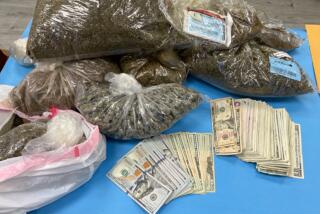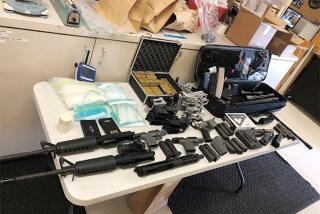4 Accused in Vista-Centered Heroin Ring
After a monthlong investigation, undercover drug agents have arrested four alleged heroin dealers who operated out of a Vista apartment, authorities said Thursday.
The four men, Mexican citizens who are legal residents of the U.S., pleaded not guilty Thursday to charges of conspiracy to distribute heroin and are being held pending a pretrial hearing, according to Special Agent Jack Hook of the Drug Enforcement Administration.
A team of Customs Service and DEA agents, assisted by San Diego County sheriff’s deputies and Oceanside police, raided the apartment in the 200 block of Palm Avenue in Vista at about 3 p.m. They arrested two men--Pedro Insunza Trias, 38, and Ismael Duarte, 37--after they ran out the back door and led agents on a short foot chase, Hook said.
Agents had already arrested Telesford Tinajero Vega, 35, as he walked with an undercover agent on Melrose Drive in Oceanside. They also arrested Arturo Morales Tsintzun, 23, in Oceanside.
Tinajero will be charged with illegal weapons possession because he was carrying a 9-millimeter pistol, officials said. Two more guns were seized at the Palm Avenue apartment.
The investigation began in March when DEA and Customs agents infiltrated the alleged heroin-dealing ring, received samples of black tar heroin and methamphetamine, and eventually bought three quarters of an ounce of heroin for $3,400, agents said.
Hook said it is not yet clear whether the men were involved in smuggling the heroin across the border from Mexico, which is a prime source country for black tar heroin.
“We are going to further our investigation to determine their ties to Mexico and how in fact they got the black tar heroin,” he said.
The sale by the Vista ring of methamphetamine continues a trend in which more Latino drug traffickers are involved in distribution and production of that drug, formerly the province of biker-type criminal organizations, Hook said.
Investigators attribute this shift to a 1988 law that made the source chemicals for methamphetamine more scarce in the U.S., thereby causing dealers to use smuggled chemicals from Mexico, he said.
More to Read
Sign up for Essential California
The most important California stories and recommendations in your inbox every morning.
You may occasionally receive promotional content from the Los Angeles Times.










